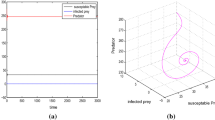Abstract
A Leslie–Gower–Holling type II model is modified to introduce a contagious disease in the predator population, assuming that disease cannot propagate to the prey. All the system’s equilibria are determined and the behaviour of the system near them is investigated. The main mathematical issues are global stability and bifurcations for some of the equilibria, together with sufficient conditions for persistence of the ecosystem. Counterintuitive results on the role played by intraspecific competition are highlighted.







Similar content being viewed by others
References
Malchow, H., Petrovskii, S., Venturino, E.: Spatiotemporal Patterns in Ecology and Epidemiology, CRC, Boca Raton (2008)
Hadeler, K.P., Freedman, H.I.: Predator–prey populations with parasitic infection. J. Math. Biol. 27, 609–631 (1989)
Freedman, H.I.: A model of predator–prey dynamics modified by the action of a parasite. Math. Biosci. 99, 143–155 (1990)
Beltrami, E., Carroll, T.O.: Modelling the role of viral disease in recurrent phytoplankton blooms. J. Math. Biol. 32, 857–863 (1994)
Venturino, E.: The influence of diseases on Lotka-Volterra systems. Rocky Mt. J. Math. 24, 381–402 (1994)
Venturino, E.: Epidemics in predator–prey models: disease among the prey. In: Arino, O., Axelrod, D., Kimmel, M., Langlais, M. (eds.) Mathematical Population Dynamics: Analysis of Heterogeneity. Theory of Epidemics, vol. 1, , pp. 381–393. Wuertz, Winnipeg (1995)
Venturino, E.: Epidemics in predator–prey models: disease in the predators. IMA J. Math. Appl. Med. Biol. 19, 185–205 (2002)
Venturino, E.: The effects of diseases on competing species. Math. Biosci. 174, 111–131 (2001)
Arino, O., Abdllaoui, A.E., Mikram, J., Chattopadhyay, J.: Infection in prey population may act as biological control in ratio-dependent predator–prey models. Nonlinearity 17, 1101–1116 (2004)
Chattopadhyay, J., Arino, O.: A predator–prey model with disease in the prey. Nonlinear Anal. 36, 747–766 (1999)
Haque, M., Venturino, E.: Increase of the prey may decrease the healthy predator population in presence of a disease in the predator. HERMIS 7, 39–60 (2006)
Haque, M., Venturino, E.: The role of transmissible diseases in the Holling–Tanner predator–prey model. Theor. Popul. Biol. 70, 273–288 (2006)
Haque, M., Venturino, E.: An ecoepidemiological model with disease in the predator; the ratio-dependent case. Math. Methods Appl. Sci. 30, 1791–1809 (2007)
Aziz-Alaoui, M.A.: Study of a Leslie–Gower–type tritrophic population. Chaos Solitons Fractals 14(8), 1275–1293 (2002)
Letellier, C., Aziz-Alaoui, M.A.: Analysis of the dynamics of a realistic ecological model. Chaos Solitons Fractals 13(1), 95–107 (2002)
Letellier, C., Aguirre, L., Maquet, J., Aziz-Alaoui, M.A.: Should all the species of a food chain be counted to investigate the global dynamics? Chaos Solitons Fractals 13(5), 1099–1113 (2002)
Upadhyay, R.K., Rai, V.: Why chaos is rarely observed in natural populations. Chaos Solitons Fractals 8(12), 1933–1939 (1997)
Korobeinikov, A.: A Lyapunov function for Leslie–Gower prey–predator models. Appl. Math. Lett. 14(6), 697–699 (2001)
Gard, T.C., Hallam, T.G.: Persistence in food web-1, Lotka–Volterra food chains. Bull. Math. Biol. 41, 877–891 (1979)
Liu, R., Duvvuri, V.R.S.K., Wu, J.: Spread pattern formation of H5N1-avian influenza and its implications for control strategies. Math. Model. Nat. Phenom. 3(7), 161–179 (2008)
Hethcote, H.W.: The mathematics of infectious diseases. SIAM Rev. 42, 599–653 (2000)
Author information
Authors and Affiliations
Corresponding author
Rights and permissions
About this article
Cite this article
Sarwardi, S., Haque, M. & Venturino, E. Global stability and persistence in LG–Holling type II diseased predator ecosystems. J Biol Phys 37, 91–106 (2011). https://doi.org/10.1007/s10867-010-9201-9
Received:
Accepted:
Published:
Issue Date:
DOI: https://doi.org/10.1007/s10867-010-9201-9




